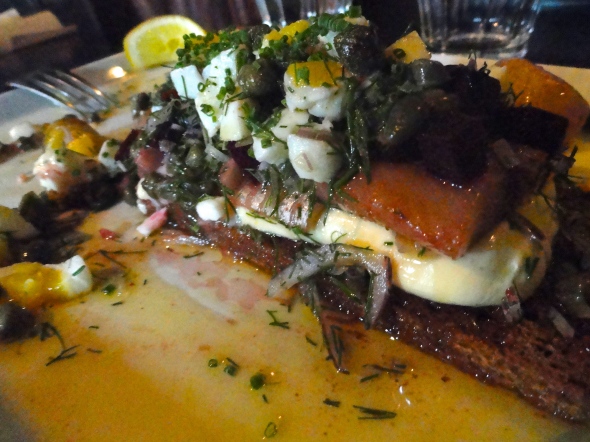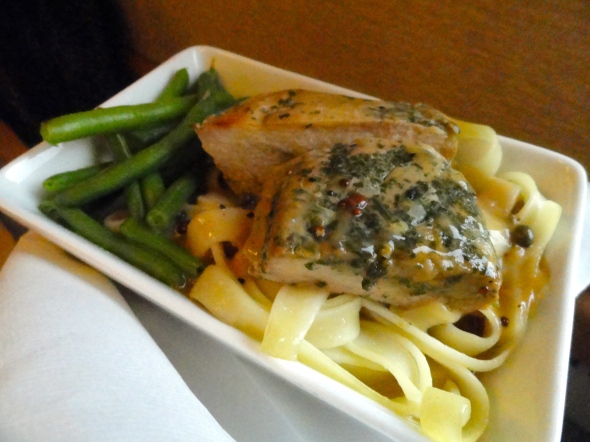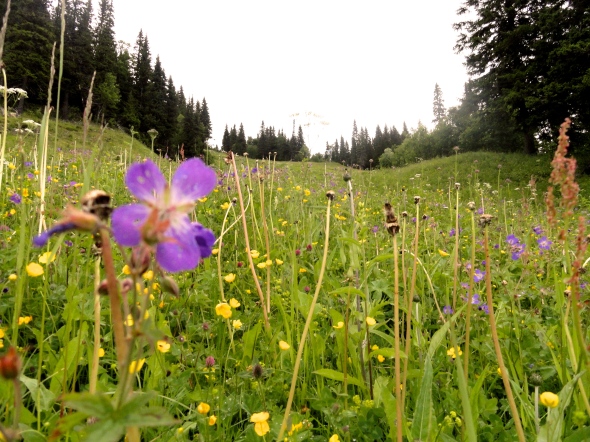Swedish train gastronomy
Posted: December 29, 2013 Filed under: Uncategorized | Tags: SJ, Sweden, Swedish state train services, train, travel Leave a commentJudging by the common complaints against the Swedish state train services (SJ) – the constant delays and breakdowns, the high prices, and the 50 years of overdue track repairs – I never expected much of their food. But given SJ’s weird booking system, I recently came across a first class ticket between Lund-Nässjö which oddly was cheaper than a 2nd class ticket. Having saved 100 kronor by travelling first class, I opted for the “Three Course Menu” for 145 Swedish kronor (appox. 16 euros) with quite some excitement.
Having rolled out of a rainy Lund with only 1h 30 to eat, I was delighted that the food arrived promptly after 20 minutes. It was so hot that I burnt my finger, and the entire meal was presented on a tray like airplane food. The heavy china with the SJ logo on was a nice touch, as well as the little note presenting the food. But my optimism was slightly quashed by the first forkful. The ‘starter’ consisted of marinated mussles with a slice of chorizo and some chopped red pepper. They were marinated in something tangy, but had a fishy aftertaste, and I set my hopes higher for the next dish.
The ‘main’ was, unfortunately, a slight downward ride from the mussels. Of course, it was foolish of me to get my hopes up for something blandly described as “Herby chicken with tagliatelle”. The chicken was hot, which was good, but rubbery at places, and the tagliatelle was overcooked. The most troubling part was the sauce, which was so thin that it kept splashing across to my fellow passenger (whom I didn’t know, and probably wasn’t appreciating my eager food analysis).
The dessert, a “Chocolate and blueberry mousse”, looked cute, but sounded like a combo that would be weird even in the poshest restaurant. Luckily, the promised fusion didn’t actually materialise – instead it tasted like soft chocolate sponge cake with some tangy chocolate mousse on top. It was decent.
All in all, the SJ lunch tasted much like airplane food, which I suppose is what you should expect given the price, the setting, and the standard of SJ services. So nothing terrible, yet not quite worthy of the lush “3 course menu” description on their website, or their elegant wine suggestions to go with it. I imagine it’s a lifetime of difference from the food on the Orient Express, where a single trip from Paris to Istanbul sets you back almost €7000. I long for trying it. Until then, I leave you with a wet photo of the Swedish countryside, to match the SJ gastronomic experience.
Ode to a beautiful, messy herring sandwich
Posted: August 3, 2013 Filed under: Uncategorized | Tags: Åre, dill, fish, herring, husmanskost, sandwich, ski slope, Sweden, Swedish, traditional 1 Comment
This is a rather short post, just a little shout-out to the best herring sandwich I ever had (I wrote about this Swedish delicacy and how to make it at home a while back). Two weeks ago I had the pleasure of attending my cousin’s wedding in the Swedish mountains, at Hotel Fjällgården in Åre, close to the border of Norway. The scenery is, as might be expected, breathtaking, but being an utter food-pig this sandwich was the star of my weekend. (Apart from the beautiful bride, of course).
This sandwich was more voluptuous than a normal matjessillmacka, as it was much bigger and, frankly a bit excessive. It had all the key building blocs: delicious matjes herring (the best kind, in my humble opinion), Swedish soured cream (gräddfil), red onion, chives, potato, warm sweet dark bread and boiled eggs. In addition, it was sprinkled with small bits of beetroot and capers, which sharpened the salty-sweet scale. But the magic ingredient was clarified butter, which was doused (very generously) on top and gave it a sweet, even caramelised flavour. Hardly healthy, of course, but ridiculously delicious. Not that one passes by Åre every other day, but if you do, make sure to take a trip up the ski slope to Fjällgården, for this sandwich is absolutely worth the hike.
Foraging for golden chanterelles
Posted: August 7, 2012 Filed under: Uncategorized | Tags: foraging, forest, golden chanterelles, mini-guide, mushrooms, Småland, Sweden, Swedish 5 CommentsBecause of the terribly rainy summer, Sweden is invaded with golden chanterelles at the moment. My stepmum complains over being bombarded with everyone’s beautifully instagrammed pictures of them on twitter. The chanterelles, which only grow in the wild, have a floral, spicy and slightly nutty flavour with hints of apricot, and are known in Sweden as the gold of the forest (and the price tag for fresh ones in London suggests there’s something to that name). All the more reason to write about these tasty beauties, so here is my mini-guide to finding, picking and eating them.
Finding. My sister-in-law who is from the dark forests of Värmland has what we in Sweden call kantarellnäsa – chanterelle nose. This has nothing to do with the appearance of her cute, shapely nose, but rather to her mysterious talent of finding these mushrooms in the wild. No matter how hard I try, I never find as many as she does. Her main tips are to look on small hills in the forest with a sunny side, in areas where birches grow sparsely together with large fir trees. If you lift the lowest branches of fir trees growing in these conditions, you can often find some chanterelles. Also, stay clear of patches of the forest where lingonberry and blueberry bushes grow, because if you find one of these you’re rather unlikely to find chanterelles nearby. Chanterelles like rainy summers but also heat, so like grape vine they enjoy hillsides where they can soak up as much warmth from the sun as possible (however they tend to live in the undergrowth, so you rarely find them in direct sunlight).
Foraging. Whilst picked berries can be placed and stored in plastic containers, mushrooms should ideally be placed in an airy basket lined with newspaper, and be wrapped in newspaper in the fridge when stored at home. If you actually make your way to Scandinavia to forage, mosquito repellent and long-sleeved thin clothing is essential. Mosquitos are simply a pain, especially in the forest if it’s been rainy and hot, which means they co-exist with the chanterelles. Also, large parts of Scandinavia have ticks in high grass, who sometimes carry Borrelia, a very serious disease if it goes untreated. So make sure to check your elbows, knees and other skin creases after coming back from the forest or meadows with high grass. If you’ve caught a tick, gently remove it with a tweezer. Normally that’s all there is to it, but if you get a red circular rash developing around the bite after a few weeks, see a doctor.
A final hazard of foraging in the wild is the risk of picking the wrong kinds of mushrooms. Unless you’re an expert, stick to picking only golden chanterelles which are unmistakably golden and hard to confuse with anything else. Do not pick any white mushrooms at all, as you might accidentally pick Vit Flugsvamp, aptly named Destroying Angel in English, which looks like this. Even a small quantity can lead to a slow and painful death, so it’s important to wash your hands if you accidentally touch one.
On the upside, most of the berries you find in the forest and meadows are perfectly edible, so after all those heavy warnings, here are some cute photos of blueberries and wild strawberries.
Cleaning. Once you’ve gathered a basketfull of chanterelles for yourself, it’s time to clean them so they are ready for the pan. For this you need a small brush and a knife to remove the bottom of the stalk with. Cut the very bottom of the stalk just to remove the dirty root, and then carefully remove any other dirt on the mushroom with a little brush. You can use an egg brush for this. This is rather time-consuming, but do not under any circumstances wash the chanterelles, as this removes a crucial part of their flavour. If you’re too impatient or scared of bacteria for this process, you may simply have to stick with green-house grown mushrooms.
Cooking. With their distinct flavour, chanterelles take-over or accompany a great array of dishes and they blend beautifully in salads with apple, in reindeer stews with lingonberry, or with scrambled eggs. However, I prefer to just enjoy them on their own, pan fried in butter, and placed on toast. This is particularly delicious if you bake your own sourdough bread and toast it on high heat in the pan you’ve cooked the chanterelles in (but baking sourdough bread is something I have yet to learn and most likely requires a mini-guide of its own). Pan-fried chanterelles require a hearty spicing of butter (and if you even consider replacing it with something lighter you might as well not bother), however you must not put it in at first, but instead turn the water out of the mushrooms by dry frying them. This is a heartbreaking process in many ways, as you’ll see your large batch of chanterelles shrink considerably.
.
.
.
.
.
.
.
Once their water has evaporated from the pan, add a large knob of butter and let the chanterelles soak in this whilst frying for a few minutes. Remove from the pan, increase the heat and pan-toast your bread in the leftover butter. Place the mushrooms on top of the toast and sprinkle with salt and white pepper before serving. Absolutely delicious.















